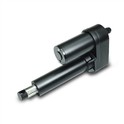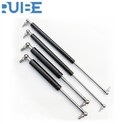As a supplier of Mini Linear Actuators, I understand the importance of protecting these precision components from dust. Dust can cause a variety of problems for Mini Linear Actuators, including increased wear and tear, reduced performance, and even complete failure. In this blog post, I will share some effective strategies for protecting Mini Linear Actuators from dust, ensuring their longevity and optimal performance.
Understanding the Impact of Dust on Mini Linear Actuators
Before we delve into the protection methods, it's crucial to understand how dust affects Mini Linear Actuators. Mini Linear Actuators are designed to provide precise linear motion, and any foreign particles, such as dust, can disrupt this motion. Dust can accumulate on the actuator's moving parts, such as the screw, nut, and bearings, causing friction and abrasion. This increased friction can lead to premature wear of the components, reducing the actuator's lifespan and performance.
Moreover, dust can also contaminate the lubricants used in the actuator, reducing their effectiveness. Lubricants play a vital role in minimizing friction and wear, and when they are contaminated with dust, they can no longer perform their intended function. This can further exacerbate the wear and tear on the actuator's components, leading to costly repairs or replacements.
Sealing the Actuator
One of the most effective ways to protect a Mini Linear Actuator from dust is to use proper sealing. Seals act as a barrier, preventing dust from entering the actuator's internal components. There are several types of seals available, including O-rings, lip seals, and bellows.
O-rings are circular seals that are typically made of rubber or silicone. They are placed in grooves around the actuator's moving parts, creating a tight seal that prevents dust from entering. Lip seals, on the other hand, are designed to have a flexible lip that conforms to the surface of the moving part, providing a dynamic seal that can adapt to the actuator's motion.
Bellows are another type of seal that can be used to protect Mini Linear Actuators from dust. Bellows are made of a flexible material, such as rubber or plastic, and are designed to expand and contract with the actuator's motion. They provide a continuous seal around the actuator, preventing dust from entering from any direction.
When selecting seals for a Mini Linear Actuator, it's important to choose seals that are compatible with the actuator's operating environment. For example, if the actuator is used in a high-temperature environment, it's important to choose seals that can withstand the high temperatures without losing their sealing properties.


Using Dust Covers
In addition to sealing the actuator, using dust covers can provide an extra layer of protection against dust. Dust covers are typically made of a flexible material, such as fabric or plastic, and are designed to fit over the actuator, protecting it from dust and other contaminants.
There are several types of dust covers available, including bellows covers, telescopic covers, and accordion covers. Bellows covers are similar to the bellows seals mentioned earlier, but they are larger and are designed to cover the entire actuator. Telescopic covers are made of a series of nested tubes that can expand and contract with the actuator's motion, providing a protective barrier around the actuator. Accordion covers are made of a flexible material that is folded into a series of pleats, allowing them to expand and contract with the actuator's motion.
When selecting a dust cover for a Mini Linear Actuator, it's important to choose a cover that is the right size and shape for the actuator. The cover should fit snugly over the actuator, providing a tight seal that prevents dust from entering. It's also important to choose a cover that is made of a durable material that can withstand the actuator's operating environment.
Maintaining a Clean Environment
Another important strategy for protecting a Mini Linear Actuator from dust is to maintain a clean environment around the actuator. This can be achieved by regularly cleaning the area where the actuator is located, using a vacuum cleaner or a compressed air gun to remove dust and other contaminants.
It's also important to avoid using the actuator in dusty or dirty environments whenever possible. If the actuator must be used in a dusty environment, it's important to take additional precautions, such as using a dust cover or sealing the actuator, to protect it from dust.
Regular Maintenance and Inspection
Regular maintenance and inspection are essential for ensuring the long-term performance and reliability of a Mini Linear Actuator. During maintenance, it's important to clean the actuator's external surfaces, remove any dust or debris that may have accumulated on the actuator, and check the seals and dust covers for any signs of wear or damage.
It's also important to lubricate the actuator's moving parts regularly, using a lubricant that is recommended by the actuator's manufacturer. Lubrication helps to reduce friction and wear, ensuring smooth and efficient operation of the actuator.
In addition to regular maintenance, it's important to inspect the actuator regularly for any signs of damage or wear. This can be done by visually inspecting the actuator's external surfaces, checking the actuator's performance, and listening for any unusual noises or vibrations. If any signs of damage or wear are detected, it's important to take immediate action to repair or replace the damaged components.
Conclusion
Protecting a Mini Linear Actuator from dust is essential for ensuring its long-term performance and reliability. By using proper sealing, dust covers, maintaining a clean environment, and performing regular maintenance and inspection, you can significantly reduce the risk of dust-related problems and extend the lifespan of your Mini Linear Actuator.
If you are interested in purchasing a Mini Linear Actuator or need more information about protecting your actuator from dust, please [contact us for procurement discussions]. We offer a wide range of high-quality Mini Linear Actuators, including 12V Linear Actuator and High Speed Linear Actuator. Our team of experts is always available to help you choose the right actuator for your application and provide you with the support and guidance you need to ensure its optimal performance.
References
- Manufacturer's manuals for Mini Linear Actuators
- Industry standards and guidelines for actuator protection
- Technical papers on the impact of dust on mechanical components






